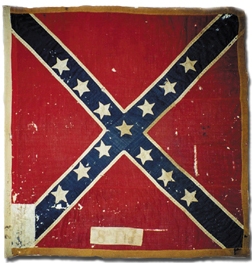History
The 2nd Florida was organized near Jacksonville, Florida on July 13, 1861, and mustered into Confederate service for a twelve-month term of enlistment with a total of one 1,185 officers and enlisted men. The regiment fielded twelve companies in total, two more than were typically authorized for an infantry regiment.The unit elected George T. Ward as its commander. Records indicate that the unit, at its founding, had an average age of twenty-three. Roughly 3% of the unit was Northern-born, including future regimental commander, Edward A. Perry. About 7% were Foreign-born; fourteen from Ireland, seven from Germany or Prussia, three from England, and one each from Canada, Cuba, Italy, Norway, and Russia. A further 3% were of Hispanic descent. [1]
In the summer of 1861, the regiment was sent to the Eastern Theater of the war and placed in the Confederacy's main army in Virginia. After arriving in Richmond on July 21, 1861, the 2nd Florida spent the next few weeks drilling and guarding Union soldiers captured after the First Battle of Manassas.
Lewis Powell, one of John Wilkes Booth's co-conspirators, lied and stated that he was 19 years old (rather than his true age of 17) in order to enlist with the Jasper Blues, Company I of the regiment. It was during their deployment in Richmond that Powell is believed to have met Booth. He secured a pass one evening and went into the city to see a play in which Booth was one of the actors. [2]
The regiment first saw combat the following year during the Peninsula Campaign. It was at the Williamsburg, on May 5, 1862, that Col. Ward was shot and killed. Several days later, the unit voted to elect Edward A. Perry as their commander. [3] The unit also participated in the battles of Seven Pines, Gaines Mill, and Malvern Hill.
Following the Peninsula Campaign, the 2nd Florida was assigned to the newly formed Florida Brigade alongside the 5th and 8th Florida. The 2nd Florida's Colonel Perry was promoted to brigadier general and given command of the brigade. Perry's Brigade served under Anderson's Division of Longstreet's First Corps, of the Army of Northern Virginia. [4]
As a component of Perry's Brigade, the 2nd Florida continued to serve through the Army of Northern Virginia's campaigns. Through the remainder of 1862, the regiment participated in the Battles of Second Manassas in August, Battle of Antietam in September, and Fredericksburg in December. In May 1863, the 2nd Florida fought in the Battle of Chancellorsville. As the Army of Northern Virginia began preparations for its invasion of Pennsylvania, Brig. Gen. Perry fell ill with typhoid and command of the Florida Brigade devolved to Colonel David Lang of the 8th. The Florida Brigade was engaged at the Battle of Gettysburg and participated in Pickett's Charge on the battle's third and final day.
After the Battles of the Wilderness and Spotsylvania in 1864, the brigade was joined by the victors of the Battle of Olustee, the 9th, 10th, and 11th Regiments. Brigadier General Joseph Finegan, the commander of Florida forces at Olustee, took command of the Florida Brigade.
The remainder of 1864 saw the 2nd Florida fight at the Battle of Cold Harbor in June and settle into static defenses at the Siege of Petersburg. Following the fall of Petersburg and Richmond the following spring, the Florida Brigade retreated with the Army of Northern Virginia and surrendered at Appomattox Court House on April 9, 1865. By the time of surrender, the regiments of the brigade were dramatically understrength. The 2nd, 5th, and 8th surrendered 68, 53, and 32 men respectively. The 9th, 10th, and 11th surrendered 124, 162, and 23. Most of the 11th had been cut off in the Army's retreat and had previously surrendered.
On May 2, 1905, Florida held a celebration to honor the U.S. government returning the 2nd Florida's battle flag to the state. [7]












